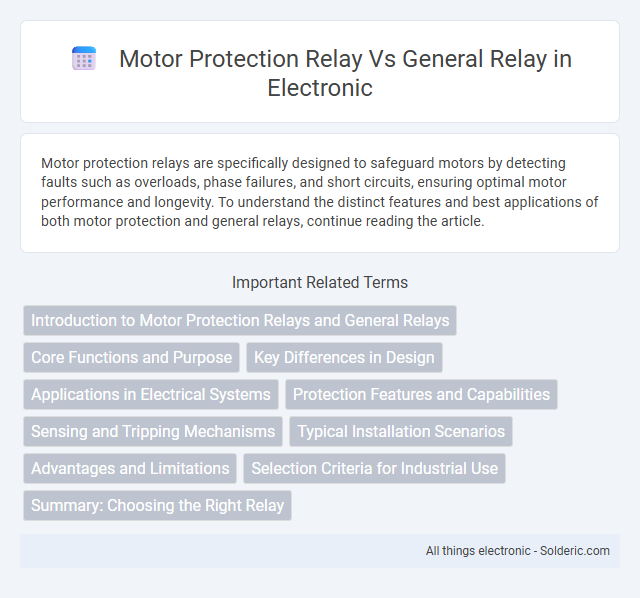Motor protection relays are specifically designed to safeguard motors by detecting faults such as overloads, phase failures, and short circuits, ensuring optimal motor performance and longevity. To understand the distinct features and best applications of both motor protection and general relays, continue reading the article.
Comparison Table
| Feature | Motor Protection Relay | General Relay |
|---|---|---|
| Purpose | Protects electric motors from faults (overload, phase failure, short circuit) | Switches electrical circuits on/off based on control signals |
| Fault Detection | Monitors motor-specific faults like thermal overload and phase imbalance | Does not perform fault detection; used for switching only |
| Operation | Combines protection, monitoring, and control functions | Simple electromechanical or solid-state switching action |
| Complexity | Advanced electronic or digital technology with multiple parameters | Simple device with on/off switching functionality |
| Application | Industrial motor control panels, automation systems | General electrical control circuits in various devices |
| Output | Triggers alarms, trips motor circuit breakers | Controls circuit continuity without protection action |
| Examples | Overload relays, phase failure relays, thermal relays for motors | Electromechanical relays, reed relays, solid-state relays |
Introduction to Motor Protection Relays and General Relays
Motor protection relays are specialized devices designed to safeguard electric motors from faults like overload, phase failure, and short circuits by continuously monitoring parameters such as current, voltage, and temperature. General relays serve broader applications by acting as electrically operated switches that control various circuits without motor-specific protective functions. The key distinction lies in motor protection relays' ability to provide targeted protection tailored to motor performance and fault conditions, enhancing motor reliability and lifespan.
Core Functions and Purpose
Motor protection relays are designed specifically to monitor and safeguard electric motors from faults such as overloads, phase failures, and short circuits by promptly disconnecting the motor to prevent damage. General relays serve broader purposes, functioning as electrically operated switches in various control and automation systems without specialized motor fault detection. The core function of motor protection relays revolves around enhancing motor reliability and longevity, whereas general relays focus on versatile switching and control applications across electrical circuits.
Key Differences in Design
Motor protection relays are specifically designed to monitor electrical parameters like current, voltage, and temperature to protect motors from faults such as overload, phase failure, and short circuits, whereas general relays primarily function as simple switching devices without advanced fault detection. The design of motor protection relays includes integrated sensors and microprocessor-based logic to provide precise protection and control tailored to motor operating conditions. Your choice depends on whether you need sophisticated motor safeguarding or basic circuit switching capabilities.
Applications in Electrical Systems
Motor protection relays are specifically designed for safeguarding electric motors by detecting faults such as overloads, phase failures, and short circuits, ensuring reliable motor operation and preventing damage. General relays serve broader purposes across electrical systems, including switching, controlling, and protecting various circuits without specialized motor diagnostics. In industrial automation and power distribution, motor protection relays are essential for maintaining motor health, while general relays provide versatile functionality in diverse electrical applications.
Protection Features and Capabilities
Motor protection relays offer advanced protection features specifically designed to safeguard electric motors, including overload, phase failure, under-voltage, and stall protection, unlike general relays that provide basic switching without specialized motor fault detection. These relays incorporate built-in diagnostics and real-time motor condition monitoring to prevent damage and extend motor lifespan. Your choice of a motor protection relay ensures enhanced reliability and precise response to motor-specific faults compared to general relays.
Sensing and Tripping Mechanisms
Motor protection relays incorporate advanced sensing mechanisms such as current, voltage, temperature, and vibration monitoring to detect motor faults early and provide precise tripping responses. In contrast, general relays typically rely on simpler overcurrent or undervoltage sensing without specialized motor condition data. Your choice of motor protection relays ensures enhanced fault detection accuracy and improved operational safety for motor applications.
Typical Installation Scenarios
Motor protection relays are typically installed in industrial settings such as manufacturing plants, HVAC systems, and pump stations to safeguard motors against overload, phase failure, and short circuits by continuously monitoring electrical parameters. General relays are more commonly found in diverse applications including control panels, automation systems, and household appliances, where they function primarily as simple switching devices without specialized motor protection features. Installation of motor protection relays requires integration with motor control centers (MCC) and often involves communication with PLCs or SCADA systems for real-time monitoring and fault diagnosis.
Advantages and Limitations
Motor protection relays offer precise fault detection and selective tripping, significantly reducing motor downtime and preventing damage from overloads, phase failure, and short circuits. Unlike general relays, they provide advanced features such as thermal modeling, phase unbalance monitoring, and communication capabilities for integration into smart systems. Limitations include higher cost and complexity compared to general relays, requiring specialized knowledge for installation and maintenance.
Selection Criteria for Industrial Use
Motor protection relays are selected based on their ability to detect overloads, phase failures, and short circuits specific to motor operation, ensuring precise motor safeguarding and minimizing downtime. General relays are chosen for broader switching functions without specialized motor protection features, emphasizing cost-efficiency and versatility in industrial control systems. Key selection criteria include fault detection accuracy, response time, compatibility with motor control circuits, and adherence to industrial safety standards such as IEC 60947-4-1.
Summary: Choosing the Right Relay
Motor protection relays offer specialized features like overload, short circuit, and phase failure protection tailored for electric motors, ensuring enhanced safety and equipment longevity. General relays provide basic switching functions without specific motor safeguards, making them suitable for simple on/off control in various applications. Selecting the right relay depends on the need for precise motor protection versus general electrical control requirements.
Motor protection relay vs general relay Infographic

 solderic.com
solderic.com